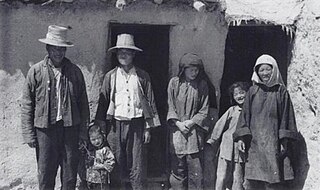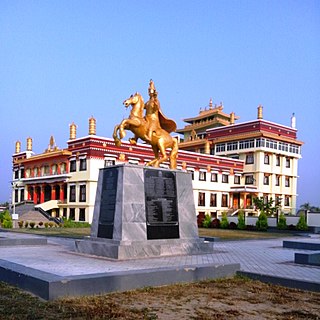Related Research Articles

Tibet, or Greater Tibet, is a region in the western part of East Asia, covering much of the Tibetan Plateau and spanning about 2,500,000 km2 (970,000 sq mi). It is the homeland of the Tibetan people. Also resident on the plateau are some other ethnic groups such as the Monpa, Tamang, Qiang, Sherpa and Lhoba peoples and, since the 20th century, considerable numbers of Han Chinese and Hui settlers. Since the annexation of Tibet by the People's Republic of China in 1951, the entire plateau has been under the administration of the People's Republic of China. Tibet is divided administratively into the Tibet Autonomous Region, and parts of the Qinghai, Gansu, Yunnan and Sichuan provinces. Tibet is also constitutionally claimed by the Republic of China as the Tibet Area since 1912. Tibet is the highest region on Earth, with an average elevation of 4,380 m (14,000 ft). Located in the Himalayas, the highest elevation in Tibet is Mount Everest, Earth's highest mountain, rising 8,848.86 m (29,032 ft) above sea level.

The Tibetan Mastiff is a large Tibetan dog breed. Its double coat is medium to long, subject to climate, and found in a wide variety of colors, including solid black, black and tan, various shades of red and bluish-gray, and sometimes with white markings around its neck, chest and legs.

The Tibetan calendar, or Tibetan lunar calendar, is a lunisolar calendar, that is, the Tibetan year is composed of either 12 or 13 lunar months, each beginning and ending with a new moon. A thirteenth month is added every two or three years, so that an average Tibetan year is equal to the solar year. The Phukpa calendar is the main Tibetan calendar, and the Karma Kagyu's Tsurluk calendar is also in current use.

Tibetan Muslims, also known as the Khache, are Tibetans who adhere to Islam. Many are descendants of Kashmiris, Ladakhis, and Nepalis who arrived in Tibet in the 14th to 17th centuries. There are approximately 5,000 Tibetan Muslims living in China, over 1,500 in India, and 300 to 400 in Nepal.

Dzogchen Monastery is one of the "Six Mother Monasteries" of the Nyingma tradition of Tibetan Buddhism. It is located in Kham within modern day Dêgê County, Garzê Tibetan Autonomous Prefecture, Sichuan, China.

Sakya PanditaKunga Gyeltsen was a Tibetan spiritual leader and Buddhist scholar and the fourth of the Five Sakya Forefathers. Künga Gyeltsen is generally known simply as Sakya Pandita, a title given to him in recognition of his scholarly achievements and knowledge of Sanskrit. He is held in the tradition to have been an emanation of Manjusri, the embodiment of the wisdom of all the Buddhas.
This is a list of topics related to Tibet.

Kyirong or Gyirong County, also known by its Chinese name Jilong, is a county of the Shigatse Prefecture, Tibet Autonomous Region, China. It is famous for its mild climatically conditions and its abundant vegetation which is unusual for the Tibetan plateau. The capital lies at Zongga (Gungthang). Its name in Tibetan, Dzongka, means "mud walls".

Jamyang Kyi is a noted Tibetan singer, feminist and writer, journalist, and a prominent television broadcaster. She was born in 1965 in Amdo, northeastern region of Tibet.

Tsepon Wangchuk Deden Shakabpa was a Tibetan nobleman, scholar, statesman and former Finance Minister of the government of Tibet.

The 14th Dalai Lama, Tenzin Gyatso, full spiritual name: Jetsun Jamphel Ngawang Lobsang Yeshe Tenzin Gyatso, also known as Tenzin Gyatso; né Lhamo Thondup; was born on the 5th day of the 5th month in the Wood-Pig Year of the Tibetan lunar calendar, July 6, 1935 in the Gregorian calendar. The incumbent Dalai Lama is the highest spiritual leader and head of Tibetan Buddhism. Before 1959, he served as both the resident spiritual and temporal leader of Tibet, and subsequently established and led the Tibetan government in exile represented by the Central Tibetan Administration in Dharamsala, India. The adherents of Tibetan Buddhism consider the Dalai Lama a living Bodhisattva, specifically an emanation of Avalokiteśvara or Chenrezig, the Bodhisattva of Compassion, a belief central to the Tibetan Buddhist tradition and the institution of the Dalai Lama. The Dalai Lama, whose name means Ocean of Wisdom, is known to Tibetans as Gyalwa Rinpoche, The Precious Jewel-like Buddha-Master, Kundun, The Presence, and Yizhin Norbu, The Wish-Fulfilling Gem. His devotees, as well as much of the Western world, often call him His Holiness the Dalai Lama, the style employed on his website. He is also the leader and a monk of the Gelug school, the newest school of Tibetan Buddhism, formally headed by the Ganden Tripa.

The Tibetan diaspora are the diaspora of Tibetan people living outside Tibet.
Tibetan literature generally refers to literature written in the Tibetan language or arising out of Tibetan culture. Historically, Tibetan has served as a trans-regional literary language that has been used, at different times, from Tibet to Mongolia, Russia, and present-day Bhutan, Nepal, India, and Pakistan. Today, the term Tibetan literature can also be applied to any work by an ethnic Tibetan person or arising out of Tibetan folk culture; contemporary Tibetan writers sometimes use Chinese, English, or other languages to compose their work.
The Mirror of News or Mirror of News from All Sides of the World was a Tibetan-language newspaper published in Kalimpong, India, from 1925 to 1963 and circulated primarily in Tibet but eventually with subscribers worldwide. Its founder was Gergan Tharchin who was at the same time its journalist, editor, and manager.

The Tibet Vernacular News, also translated as The Tibetan Vernacular News, is the first newspaper to have been established in Tibet. Besides a Chinese title and some subscription information, the newspaper was written in Tibetan (藏文) since its founding in April 1907 by amban Lian Yu 聯豫, and his deputy Zhang Yintang 張蔭堂, in the final years of the Qing dynasty. The first issue was lithographically printed, with a print-run fewer than 100 copies a day. It was disestablished in 1911. The mission of the newspaper was mainly educational, but also propagandistic. Nothing is known about how the paper was received by Tibetans.
The Association of Tibetan Journalists is a Tibetan organization in exile, that was founded in 1997 in Dharamsala, India. The organization's stated mission is to "Facilitate free, fair and accurate delivering of information regarding activities relating to the Tibetan community, both within and outside of Tibet. Function as a monitoring agency of the Tibetan Government in Exile, regarding the democratic processes implemented. Ensure the welfare and professional indemnity of Tibetan journalists within their professional jurisdiction."

The Tibet Post is an online publication founded by a group of Tibetan journalists with the primary goal of promoting democracy through freedom of expression within Tibetan communities who are both within and outside of Tibet.

Voice of Tibet is a radio station based in Norway transmitting shortwave radio programmes in the Tibetan language as well as Mandarin Chinese. The station began broadcasting on 14 May 1996 and was founded by three Norwegian NGOs: Norwegian Human Rights House, The Norwegian Tibet Committee and Worldview Rights. Its broadcasts target Tibet and China as well as India, Bhutan and Nepal. It receives funds from the United States National Endowment for Democracy.

The Lha Charitable Trust is an Indian nonprofit organization primarily focused on Tibetian social work. It was founded in 1997 in Dharamshala, India by Jampa Tsering and Niel Guidry.

The Tibet women's football team is a national association football team controlled by the Tibet Women's Soccer (TWS), an organization of exiled Tibetans. Its current team manager is Gompo Dorjee.
References
- ↑ The Tibet Times, Tibet Times project